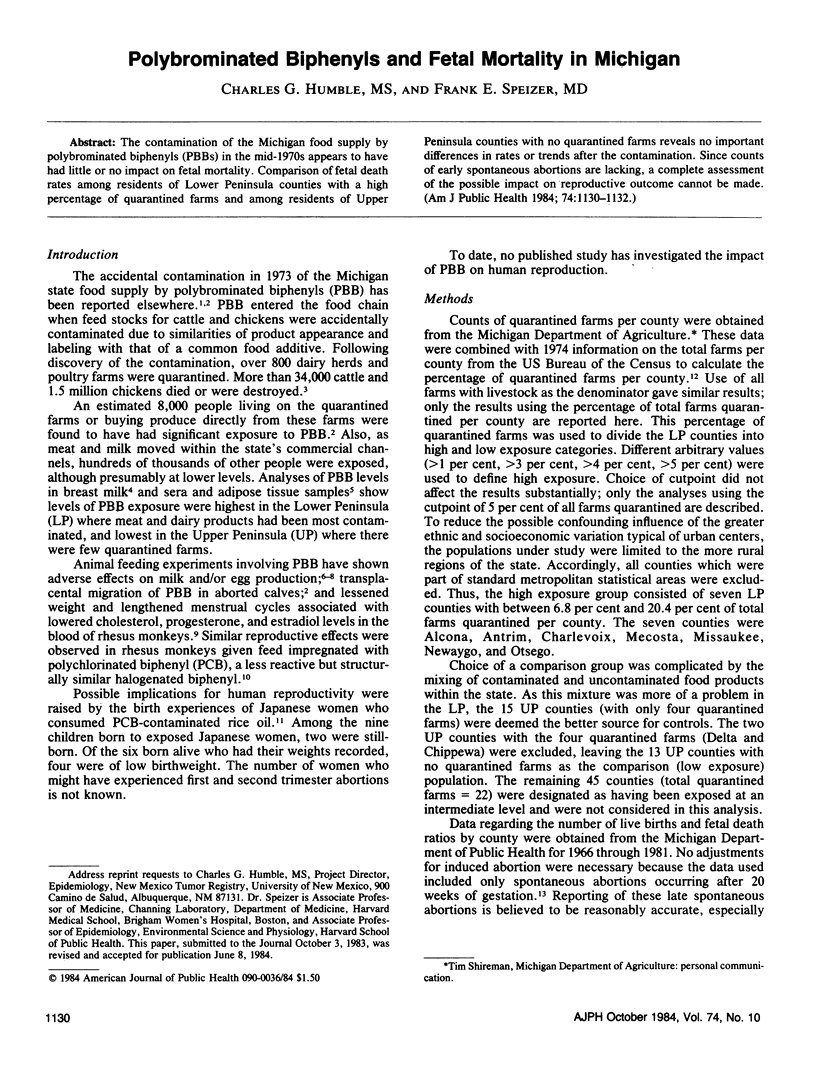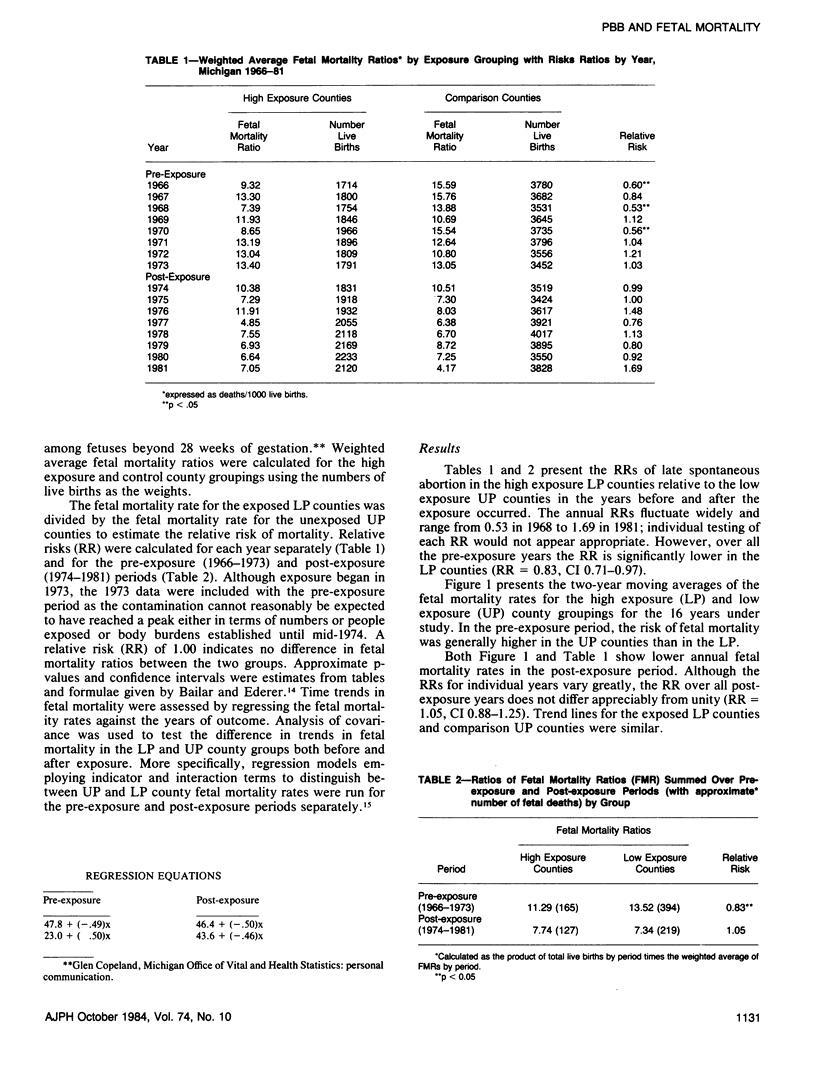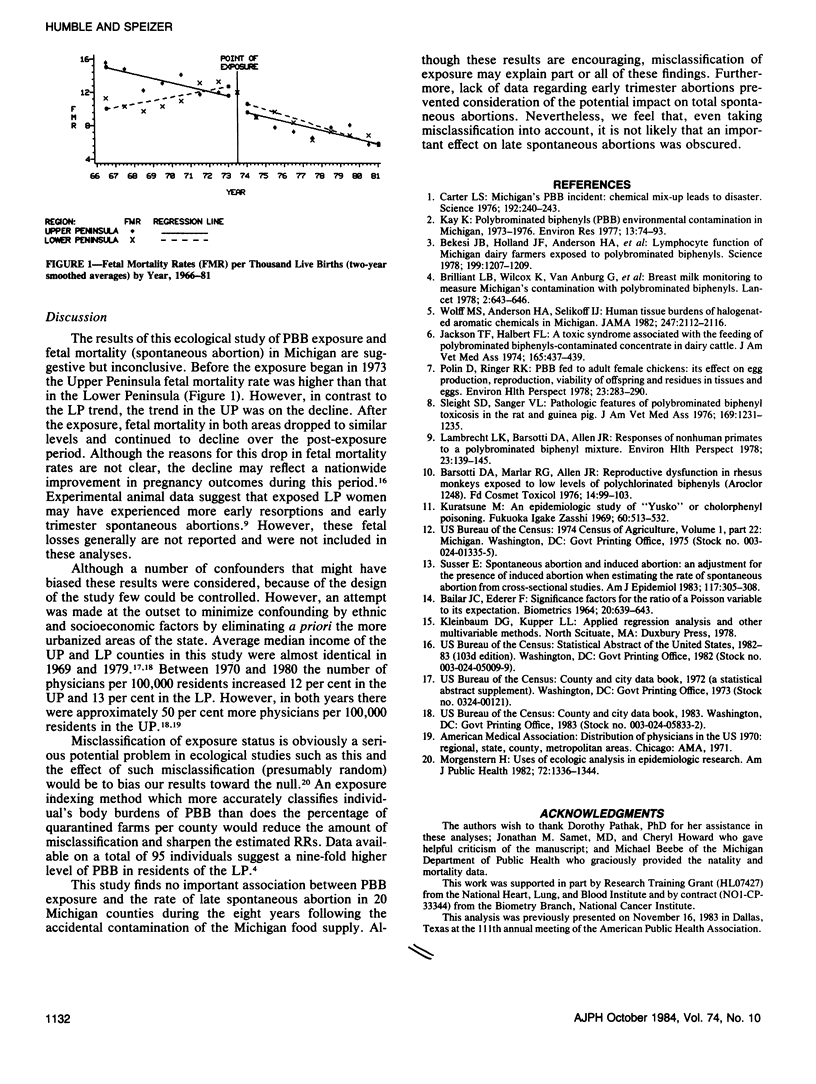Abstract
The contamination of the Michigan food supply by polybrominated biphenyls (PBBs) in the mid-1970s appears to have had little or no impact on fetal mortality. Comparison of fetal death rates among residents of Lower Peninsula counties with a high percentage of quarantined farms and among residents of Upper Peninsula counties with no quarantined farms reveals no important differences in rates or trends after the contamination. Since counts of early spontaneous abortions are lacking, a complete assessment of the possible impact on reproductive outcome cannot be made.
Full text
PDF


Selected References
These references are in PubMed. This may not be the complete list of references from this article.
- Barsotti D. A., Marlar R. J., Allen J. R. Reproductive dysfunction in rhesus monkeys exposed to low levels of polychlorinated biphenyls (Aoroclor 1248). Food Cosmet Toxicol. 1976 Apr;14(2):99–103. doi: 10.1016/s0015-6264(76)80251-9. [DOI] [PubMed] [Google Scholar]
- Bekesi J. G., Holland J. F., Anderson H. A., Fischbein A. S., Rom W., Wolff M. S., Selikoff I. J. Lymphocyte function of Michigan dairy farmers exposed to polybrominated biphenyls. Science. 1978 Mar 17;199(4334):1207–1209. doi: 10.1126/science.204005. [DOI] [PubMed] [Google Scholar]
- Brilliant L. B., Wilcox K., Van Amburg G., Eyster J., Isbister J., Bloomer A. W., Humphrey H., Price H. Breast-milk monitoring to measure Michigan's contamination with polybrominated biphenyls. Lancet. 1978 Sep 23;2(8091):643–646. doi: 10.1016/s0140-6736(78)92758-7. [DOI] [PubMed] [Google Scholar]
- Carter L. J. Michigan's PBB Incident: Chemical Mix-Up Leads to Disaster. Science. 1976 Apr 16;192(4236):240–243. doi: 10.1126/science.192.4236.240. [DOI] [PubMed] [Google Scholar]
- Jackson T. F., Halbert F. L. A toxic syndrome associated with the feeding of polybrominated biphenyl-contaminated protein concentrate to dairy cattle. J Am Vet Med Assoc. 1974 Sep 1;165(5):437–439. [PubMed] [Google Scholar]
- Kay K. Polybrominated biphenyls (PBB) environmental contamination in Michigan, 1973-1976. Environ Res. 1977 Feb;13(1):74–93. doi: 10.1016/0013-9351(77)90006-8. [DOI] [PubMed] [Google Scholar]
- Lambrecht L. K., Barsotti D. A., Allen J. R. Responses of nonhuman primates to a polybrominated biphenyl mixture. Environ Health Perspect. 1978 Apr;23:139–145. doi: 10.1289/ehp.7823139. [DOI] [PMC free article] [PubMed] [Google Scholar]
- Morgenstern H. Uses of ecologic analysis in epidemiologic research. Am J Public Health. 1982 Dec;72(12):1336–1344. doi: 10.2105/ajph.72.12.1336. [DOI] [PMC free article] [PubMed] [Google Scholar]
- Polin D., Ringer R. K. PBB fed to adult female chickens: its effect on egg production, reproduction, viability of offspring, and residues in tissues and eggs. Environ Health Perspect. 1978 Apr;23:283–290. doi: 10.1289/ehp.7823283. [DOI] [PMC free article] [PubMed] [Google Scholar]
- Sleight S. D., Sanger V. L. Pathologic features of polybrominated biphenyl toxicosis in the rat and guinea pig. J Am Vet Med Assoc. 1976 Dec 1;169(11):1231–1235. [PubMed] [Google Scholar]
- Susser E. Spontaneous abortion and induced abortion: an adjustment for the presence of induced abortion when estimating the rate of spontaneous abortion from cross-sectional studies. Am J Epidemiol. 1983 Mar;117(3):305–308. doi: 10.1093/oxfordjournals.aje.a113542. [DOI] [PubMed] [Google Scholar]
- Wolff M. S., Anderson H. A., Selikoff I. J. Human tissue burdens of halogenated aromatic chemicals in Michigan. JAMA. 1982 Apr 16;247(15):2112–2116. [PubMed] [Google Scholar]


